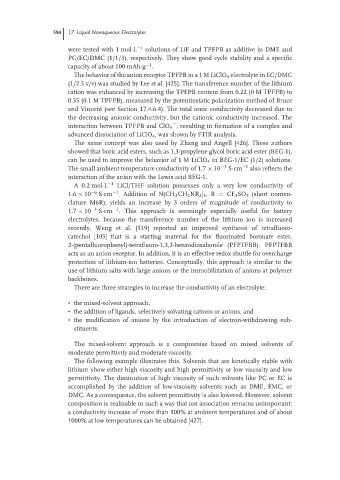Page 620 - Handbook of Battery Materials
P. 620
594 17 Liquid Nonaqueous Electrolytes
were tested with 1 mol·L −1 solutions of LiF and TPFPB as additive in DME and
PC/EC/DMC (1/1/3), respectively. They show good cycle stability and a specific
−1
capacity of about 100 mAh·g .
The behavior of the anion receptor TPFPB in a 1 M LiClO 4 electrolyte in EC/DMC
(1/2.5 v/v) was studied by Lee et al. [425]. The transference number of the lithium
cation was enhanced by increasing the TPFPB content from 0.22 (0 M TPFPB) to
0.55 (0.1 M TPFPB), measured by the potentiostatic polarization method of Bruce
and Vincent (see Section 17.4.6.4). The total ionic conductivity decreased due to
the decreasing anionic conductivity, but the cationic conductivity increased. The
−
interaction between TPFPB and ClO 4 , resulting in formation of a complex and
advanced dissociation of LiClO 4 , was shown by FTIR analysis.
The same concept was also used by Zhang and Angell [426]. These authors
showed that boric acid esters, such as 1,3-propylene glycol boric acid ester (BEG-1),
can be used to improve the behavior of 1 M LiClO 4 in BEG-1/EC (1/2) solutions.
The small ambient temperature conductivity of 1.7 × 10 −3 S·cm −1 also reflects the
interaction of the anion with the Lewis acid BEG-1.
A0.2 mol·L −1 LiCl/THF solution possesses only a very low conductivity of
1.6 × 10 −6 S·cm −1 . Addition of N(CH 2 CH 2 NR 2 ] 3 ,R = CF 3 SO 2 (short nomen-
clature M6R), yields an increase by 3 orders of magnitude of conductivity to
−1
1.7 × 10 −3 S·cm . This approach is seemingly especially useful for battery
electrolytes, because the transference number of the lithium ion is increased
recently, Weng et al. [519] reported an improved synthesis of tetrafluoro-
catechol [105] that is a starting material for the fluorinated boronate ester,
2-(pentafluorophenyl)-tetrafluoro-1,3,2-benzodioxaborole (PFPTFBB). PFPTFBB
acts as an anion receptor. In addition, it is an effective redox shuttle for overcharge
protection of lithium-ion batteries. Conceptually, this approach is similar to the
use of lithium salts with large anions or the immobilization of anions at polymer
backbones.
There are three strategies to increase the conductivity of an electrolyte:
• the mixed-solvent approach,
• the addition of ligands, selectively solvating cations or anions, and
• the modification of anions by the introduction of electron-withdrawing sub-
stituents.
The mixed-solvent approach is a compromise based on mixed solvents of
moderate permittivity and moderate viscosity.
The following example illustrates this. Solvents that are kinetically stable with
lithium show either high viscosity and high permittivity or low viscosity and low
permittivity. The diminution of high viscosity of such solvents like PC or EC is
accomplished by the addition of low-viscosity solvents such as DME, EMC, or
DMC. As a consequence, the solvent permittivity is also lowered. However, solvent
composition is realizable in such a way that ion association remains unimportant;
a conductivity increase of more than 100% at ambient temperatures and of about
1000% at low temperatures can be obtained [427].

